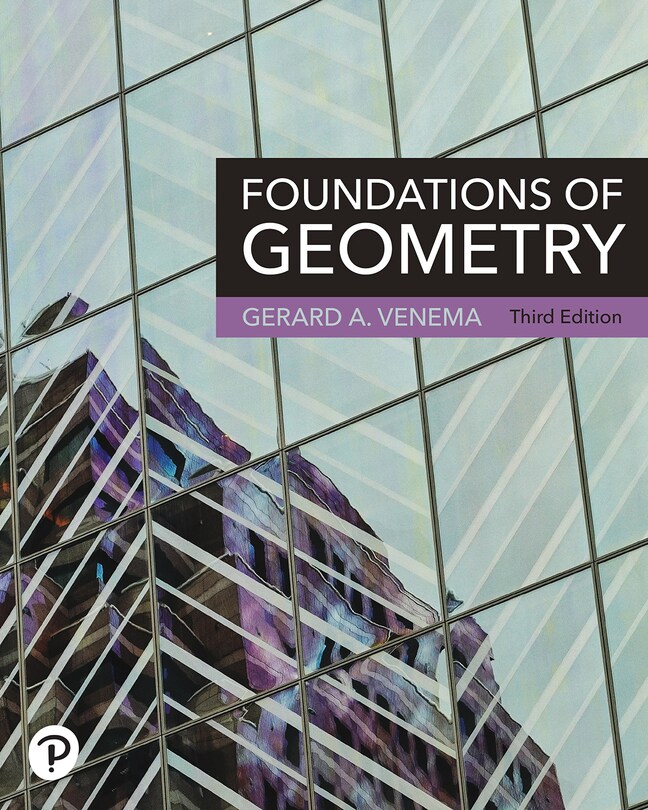
Foundations of Geometry, 3rd edition
- Gerard A. Venema

- Study simpler and faster
Use flashcards and other study tools in your eTextbook
- Listen on the go
Learn how you like with full eTextbook audio
- Find it fast
Quickly navigate your eTextbook with search
- Stay organized
Access all your eTextbooks in one place
- Easily continue access
Keep learning with auto-renew
Experience the beauty and fascination of geometry with Foundations of Geometry. This text enriches the education of all mathematics majors and encourages a smooth transition into more advanced courses. Comprehensive coverage of most of Euclid's Elements includes almost all the material in the first 6 books of that work. A study of geometry in the real world examines some non-traditional models and curved spaces. In the 3rd Edition, Venema implements the latest national standards and recommendations regarding geometry for the preparation of high school mathematics teachers, and encourages you to make connections between your college courses and classes you will later teach.
Published by Pearson (July 30th 2021) - Copyright © 2022
ISBN-13: 9780136845294
Subject: Geometry
Category: Introductory Geometry
1. Prologue: Euclid's Elements
1.1 Geometry before Euclid
1.2 The Logical Structure of Euclid's Elements
1.3 The Historical Significance of Euclid's Elements
1.4 A Look at Book I of the Elements
1.5 A Critique of Euclid's Elements
1.6 A New View of the Foundations
1.7 Some Final Observations about the Elements
2. Axiomatic Systems and Incidence Geometry
2.1 The Structure of an Axiomatic System
2.2 An Example: Incidence Geometry
2.3 The Parallel Postulates in Incidence Geometry
2.4 Axiomatic Systems and the RealWorld
2.5 Theorems, Proofs, and Logic
2.6 Some Theorems from Incidence Geometry
3. A System of Axioms for Plane Geometry
3.1 The Undefined Terms and Two Fundamental Axioms
3.2 Distance and the Ruler Postulate
3.3 The Plane Separation Postulate
3.4 Angle Measure and the Protractor Postulate
3.5 The Crossbar Theorem and the Linear Pair Theorem
3.6 The Side-Angle-Side Postulate
3.7 The Parallel Postulates and Models for Neutral Geometry
4. Neutral Geometry
4.1 The Exterior Angle Theorem
4.2 Triangle Congruence Conditions
4.3 Three Inequalities for Triangles
4.4 The Alternate Interior Angles Theorem
4.5 The Saccheri-Legendre Theorem
4.6 Quadrilaterals
4.7 Statements Equivalent to the Euclidean Parallel Postulate
4.8 Rectangles and Defect
4.9 The Universal Hyperbolic Theorem
5. Euclidean Geometry
5.1 Basic Theorems of Euclidean Geometry
5.2 The Parallel Projection Theorem
5.3 Similar Triangles
5.4 The Pythagorean Theorem
5.5 Trigonometry
5.6 Exploring the Geometry of Euclidean Triangles
6. Hyperbolic Geometry
6.1 Basic Theorems of Hyperbolic Geometry
6.2 Common Perpendiculars
6.3 The Angle of Parallelism
6.4 Limiting Parallel Rays
6.5 Asymptotic Triangles
6.6 The Classification of Parallels
6.7 The Critical Function
6.8 The Defect of a Triangle
6.9 Is the Real World Hyperbolic?
7. Area
7.1 The Neutral Area Postulate
7.2 Area in Euclidean Geometry
7.3 Dissection Theory
7.4 Proof of the Dissection Theorem in Euclidean Geometry
7.5 The Associated Saccheri Quadrilateral
7.6 Area and Defect in Hyperbolic Geometry
7.7 The Euclidean Area Postulate Reconsidered
8. Circles
8.1 Circles and Lines in Neutral Geometry
8.2 Circles and Triangles in Neutral Geometry
8.3 Circles in Euclidean Geometry
8.4 Circular Continuity
8.5 Circumference and Area of Euclidean Circles
8.6 Exploring Euclidean Circles
9. Constructions
9.1 Compass and Straightedge Constructions in Geometry
9.2 Neutral Constructions
9.3 Euclidean Constructions
9.4 Construction of Regular Polygons
9.5 Area Constructions
9.6 Three Impossible Constructions
10. Transformations
10.1 Isometries of the Plane
10.2 Rotations, Translations, and Glide Reflections
10.3 Classification of Euclidean Motions
10.4 Classification of Hyperbolic Motions
10.5 A Transformational Approach to the Foundations
10.6 Similarity Transformations in Euclidean Geometry
10.7 Euclidean Inversions in Circles
11. Models
11.1 The Cartesian Model for Euclidean Geometry
11.2 The Poincaré Disk Model for Hyperbolic Geometry
11.3 Other Models for Hyperbolic Geometry
11.4 Models for Elliptic Geometry
12. Polygonal Models and the Geometry of Space
12.1 Curved Surfaces
12.2 Approximate Models for the Hyperbolic Plane
12.3 Geometric Surfaces
12.4 The Geometry of the Universe
12.5 Conclusion
12.6 Further Study
12.7 Templates
A. Euclid's Book I
A.1 Definitions
A.2 Postulates
A.3 Common Notions
A.4 Propositions
B. Systems of Axioms for Geometry
B.1 Hilbert's Axioms
B.2 Birkhoff's Axioms
B.3MacLane'sAxioms
B.4 SMSG Axioms
B.5 UCSMP Axioms
C. The Postulates Used in This Book
C.1 Criteria Used in Selecting the Postulates
C.2 Statements of the Postulates
C.3 Logical Relationships
D. The Van Hiele Model of the Development of Geometric Thought
E. Set Notation and the Real Numbers
E.1 Some Elementary Set Theory
E.2 Axioms for the Real Numbers
E.3 Properties of the Real Numbers
E.4 One-to-One and Onto Functions
E.5 Continuous Functions
F. Hints for Selected Exercises
Bibliography
Index